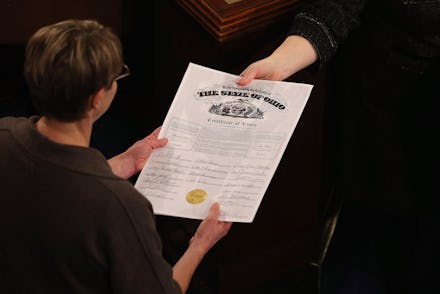Here’s how the Electoral College, the process that selects the next US president, works.

The upset and controversy that followed the 2016 presidential election — in which Democratic nominee Hillary Clinton won the popular vote, but lost the Electoral College to Republican President-elect Donald Trump — has led many Americans to wonder if it was truly worth casting their vote if the Electoral College always ends up choosing the next president.
In 2000, Democratic candidate Al Gore won the popular vote, but GOP candidate George W. Bush defeated him after earning 271 electoral votes.
In addition to 1824, 1876, 1888 and 2000, the 2016 election results became the fifth case in which the Electoral College handed victory to the loser of the popular vote.
The role of the Electoral College will be put to test again next week when GOP electors and delegates from across the country will gather to cast their ballots, while millions of Americans are watching horrified how a Trump administration is taking shape, according to the New York Times. Some GOP electors have expressed their disdain for Trump, but an Associated Press poll found that the 330 surveyed electors from both parties have "little appetite for a revolt." Whether they like Trump or not, Republican electors will choose to ratify the popular vote in their respective home states, the Hill reported.
So how does the Electoral College work? Here are some points to consider.
What is the Electoral College?
According to the National Archives and Records Administration website, the Electoral College is a process, not a place. The founding fathers established it in Article 2, Section 1 and in the 12th Amendment of the Constitution. The Electoral College is comprised of 538 electors, from which a majority of 270 are needed to elect the president. The 538 electors are the sum of 435 representatives, 100 senators, and 3 electors allocated to the District of Columbia.
How does it work?
The candidate who wins the majority of votes in a state will automatically win that state's electoral votes, with the exception of Maine and Nebraska, where two electoral votes are assigned to the winner of the popular vote statewide, and then each one to the winner in each congressional district. The six states with the largest number of electoral votes are California (55), Texas (38), New York (29), Florida (29), Pennsylvania (20) and Illinois (20). The smallest states by population — Alaska, Delaware, Montana, North Dakota, South Dakota, Vermont and Wyoming — get three electors each, since they are represented by one representative and two senators.
How are they selected?
First, the political parties in each state either nominate potential electors at their state party conventions or they choose them at the party's central committee, according to the National Archives. These can be state elected officials, state party leaders, or people who have political affiliation with the party's presidential hopeful.
The second part of the process occurs every Nov. 8. As voters in each state choose who the next president will be, they're also casting votes to select their state's electors. Elector's names do not necessarily appear on every state's ballots, depending on election procedures and ballot formats.
Do they have to vote for their party's candidate?
Though electors are affiliated with a political party, neither a constitutional provision nor federal law that compel electors to vote for their own party's candidate. Nevertheless, some states require electors to cast their votes according to the popular vote.
What happens if no candidate wins the majority of Electoral College votes?
If all participating candidates are short of reaching the 270 electoral vote threshold, the U.S. House of Representatives will select the president from the top three contenders who received the most electoral votes, with each state delegation having one vote. The Senate would elect the vice president from the two vice presidential candidates who earned the most electoral votes. If this process fails by inauguration day, the vice-president elect will serve as acting president until the gridlock is resolved in the House of Representatives.
Although a tie is statistically remote, state legislation should rule how to break the tie. A close finish could also lead to a runoff election or legal action to decide the president.
Why is it so controversial?
The founding fathers created the Electoral College because they did not trust direct democracy. James Madison in Federalist 10 argued that government systems based on pure democracy "have ever been found incompatible with personal or the rights of property." Alexander Hamilton in Federalist 68 said that "a small number of persons, selected by their fellow-citizens from the general mass" should be able to pick the president.
But in light of the 2000 and 2016 elections, some voices have called to end the Electoral College. "The system favors the GOP because too many liberal voters live in two few (primarily coastal) states," Scott Piro wrote for CNN. Peter Beinart, of the Atlantic, argues that the Electoral College was created because the framers "were afraid of people choosing a demagogue." He added: "Electors are not the independent-minded figures Hamilton envisioned."
But striking down the Electoral College is not as easy as it sounds. "The obstacles required to eliminate the Electoral College — passing a constitutional amendment via two-thirds majority in both houses of Congress and ratified by three-fourths of the states — are unlikely to overcome without GOP support," Piro wrote.